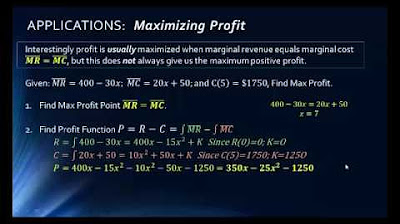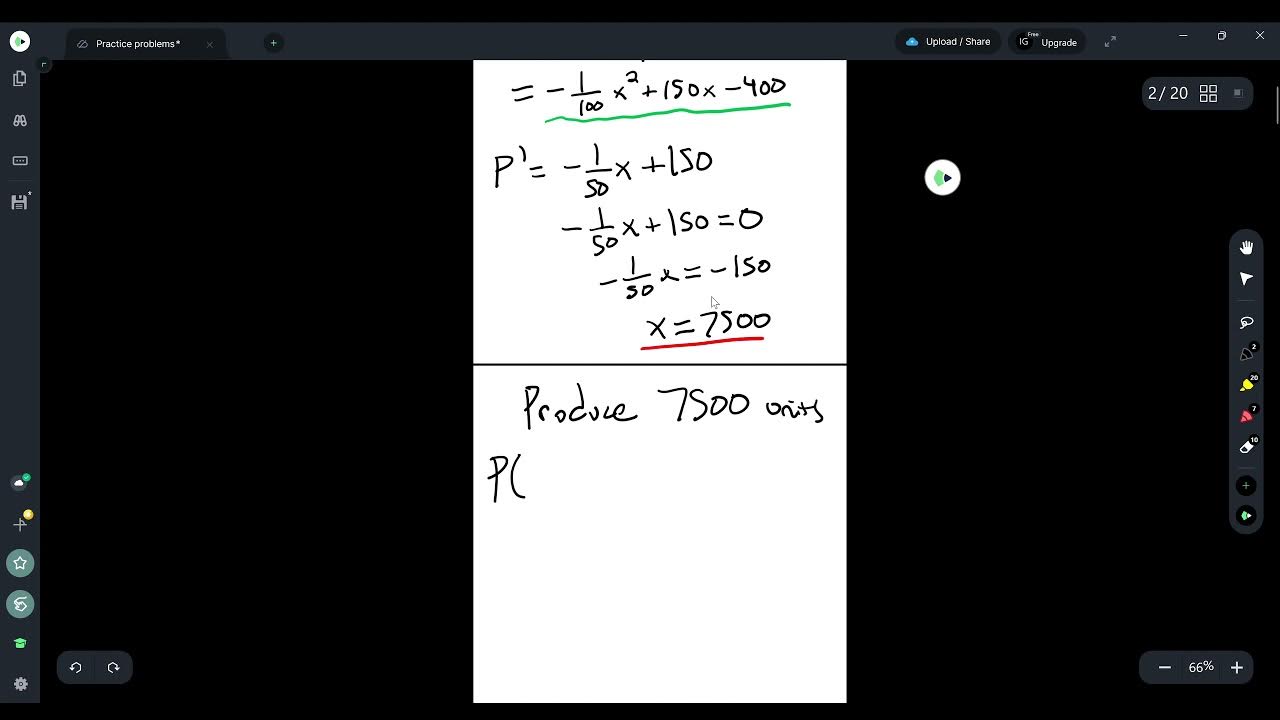Marginal Cost, Marginal Revenue, and Marginal Profit
TLDRThe video script discusses cost, demand, and profit functions in the context of a company's production decisions. It explains how to calculate the average selling price, revenue, total cost, and profit at a specific production level. The script then demonstrates how to find the production level that maximizes profit by setting the first derivative of the profit function to zero. It also introduces the concepts of marginal profit, marginal revenue, and marginal cost, and their roles in determining the optimal production level for maximizing profit. The video concludes with a practical example of calculating the maximum profit and the associated production level.
Takeaways
- 📉 The average selling price at a production level of 500 units is $45 per unit, calculated by taking the given price function ($50 - $0.01 * quantity) and plugging in 500 units.
- 💰 The total revenue at a production level of 500 units is $22,500, which is found by multiplying the production level (500 units) by the average price per unit ($45).
- 📈 The total cost at a production level of 500 units is $7,000, as provided by the total cost function.
- 🚀 The profit at a production level of 500 units is $15,500, which is calculated by subtracting the total cost ($7,000) from the total revenue ($22,500).
- 🔍 To find the production level that maximizes profit, we set the first derivative of the profit function (marginal profit) equal to zero and solve for the production level (x).
- 🏆 The production level that maximizes profit is 1,150 units, as determined by setting the marginal revenue equal to the marginal cost and solving for x.
- 🌟 The maximum profit the company can achieve is $23,950 by selling 1,150 units, calculated using the profit function at the optimal production level.
- 📊 The marginal profit at a production level of 500 units is $26 per unit, indicating the approximate change in profit if an additional unit is sold.
- 🔄 The marginal profit, marginal revenue, and marginal cost are all important concepts for understanding how changes in production levels affect a company's financial outcomes.
- 📝 The profit, revenue, and cost functions are essential tools for businesses to make informed decisions about production levels and pricing strategies.
Q & A
What is the average selling price at a production level of 500 units?
-The average selling price at a production level of 500 units is $45 per unit.
How is the revenue calculated for 500 units?
-The revenue for 500 units is calculated by multiplying the production level (500) by the selling price ($45), which results in a total revenue of $22,500.
What is the total cost at a production level of 500 units?
-The total cost at a production level of 500 units is $7,000.
What is the profit at a production level of 500 units?
-The profit at a production level of 500 units is $15,500, which is the difference between the revenue ($22,500) and the total cost ($7,000).
How can you find the production level that maximizes profit?
-To find the production level that maximizes profit, you set the first derivative of the profit function (marginal profit) equal to zero and solve for x. Alternatively, you set the marginal revenue equal to the marginal cost.
What production level results in the maximum profit?
-A production level of 1,150 units results in the maximum profit.
What is the maximum profit the company can make?
-The maximum profit the company can make is $23,950 by selling 1,150 units.
What does the marginal profit at a production level of 500 units indicate?
-The marginal profit at a production level of 500 units is $26 per unit, which represents the approximate increase in profit when selling one additional unit.
How do you calculate the marginal profit at a production level of 500 units?
-The marginal profit at a production level of 500 units is calculated by evaluating the derivative of the profit function at x=500, which is 46 - 0.04(500), resulting in $26.
What do marginal revenue and marginal cost represent?
-Marginal revenue represents the change in revenue when selling one more unit, and marginal cost represents the change in total cost when producing and selling one additional unit.
How can you verify that the calculated production level indeed results in the maximum profit?
-You can verify this by calculating the profit at various production levels around the calculated maximum (1,150 units), such as 1,000, 1,300, and 1,500 units, and comparing the profits to ensure that the calculated maximum is indeed the highest value.
Outlines
📈 Price Function and Revenue Calculation
This paragraph explains the concept of the price function, which is also known as the demand function, and how it differs from the profit function. It provides a specific example where the average selling price is calculated for 500 units of production. The paragraph then moves on to explain the revenue function, showing how to calculate total revenue at a production level of 500 units. The explanation includes a breakdown of the revenue equation and a clear demonstration of how the total revenue of $22,500 is derived from selling 500 units at $45 per unit.
💰 Total Cost, Profit Calculation, and Profit Maximization
The second paragraph delves into the total cost and profit of the company at a production level of 500 units. It begins by calculating the total cost and then moves on to determine the profit by subtracting the cost from the revenue. The paragraph also introduces the concept of profit maximization, explaining how to find the production level that yields the maximum profit. This is done by setting the first derivative of the profit function (marginal profit) equal to zero, which results in the optimal production level of 1150 units. The paragraph concludes with a calculation of the maximum profit, which is $23,950, and verifies this by comparing profits at different production levels.
📊 Marginal Profit Calculation and Analysis
This paragraph focuses on the calculation and interpretation of marginal profit. It defines marginal profit as the change in profit for selling an additional unit and provides the formula for calculating it. The paragraph calculates the marginal profit at a production level of 500 units and explains its significance. It also compares the marginal profit at 500 units with the profit change when producing one more unit. Furthermore, the paragraph explains the concepts of marginal revenue and marginal cost, highlighting their importance in understanding the financial impact of changes in production levels.
Mindmap
Keywords
💡Cost and Demand Functions
💡Average Selling Price
💡Revenue Function
💡Total Cost
💡Profit Function
💡Marginal Profit
💡Maximum Profit
💡Marginal Revenue
💡Marginal Cost
💡First Derivative
💡Optimal Production Level
Highlights
The average selling price at a production level of 500 units is $45 per unit.
The revenue function is defined as the production level times the selling price, represented as x times (50 - 0.01x).
At a production level of 500 units, the total revenue is $22,500.
The total cost at a production level of 500 units is $7,000.
The profit function is the difference between the revenue function and the cost function.
The profit at a production level of 500 units is $15,500.
To maximize profit, the production level should be set where the marginal profit is equal to zero.
The production level that maximizes profit is 1150 units.
The maximum profit the company can make is $23,950 by selling 1150 units.
The marginal profit at a production level of 500 units is $26 per unit.
Marginal profit represents the change in profit if an additional unit is sold.
Marginal revenue and marginal cost help in understanding the change in revenue and cost for selling an additional unit.
The maximum profit is confirmed by comparing profits at different production levels around the maximum point.
The profit decreases as production levels move away from the optimal level of 1150 units.
The concepts of marginal profit, revenue, and cost are crucial for business decision-making.
The video provides a comprehensive understanding of cost, demand, revenue, and profit functions in a business context.
Transcripts
Browse More Related Video
5.0 / 5 (0 votes)
Thanks for rating:





